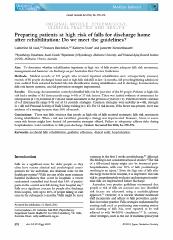Please use this identifier to cite or link to this item:
https://ahro.austin.org.au/austinjspui/handle/1/13770| Title: | Preparing patients at high risk of falls for discharge home after rehabilitation: Do we meet the guidelines? | Austin Authors: | Said, Catherine M ;Batchelor, Frances;Shaw, Kathryn;Blennerhassett, Jannette | Affiliation: | Physiotherapy Department, Austin Health, Heidelberg, Victoria, Australia Department of Physiotherapy, Melbourne University, Melbourne, Victoria, Australia National Ageing Research Institute (NARI), Melbourne, Victoria, Australia |
Issue Date: | May-2016 | Date: | 2015-05-15 | Publication information: | Geriatrics & Gerontology International 2016; 16(5):570-576 | Abstract: | Aim: To determine whether rehabilitation inpatients at high risk of falls receive adequate falls risk assessment, management and handover on discharge as per Australian Best Practice Guidelines. Methods: Medical records of 121 people who received inpatient rehabilitation were retrospectively screened; records of 50 people discharged home and at high falls risk (fall in last 12 months, fall preceding/during admission) were audited. Data extracted included falls risk identification during rehabilitation and in discharge documentation; falls risk factors assessed; and fall prevention strategies implemented. Results: Discharge documentation correctly identified falls risk for just nine of the 50 people. Patients at high falls risk had a median of 8.0 (interquartile range 6–10) of 17 risk factors. There was limited evidence of assessment for osteoporosis (n = 8), footwear (n = 4) and visual assessment in the previous 2 years (n = 1). Patients received a median of 6.5 (interquartile range 5–9) out of 16 possible strategies. Common strategies were mobility (n = 48), strength (n = 44) and Personal Activity of Daily Living training (n = 43). For 12 risk factors, if the factor was present, there was evidence of a strategy in more than 80% of records. Conclusions: There was little evidence that people at high risk of falls received systematic falls risk assessment during rehabilitation. When a risk was identified, generally a strategy was implemented. However, failure to assess some risk factors might have limited fall prevention strategies offered. Failure to adequately address risks during hospitalization could contribute to falls post-discharge. | URI: | https://ahro.austin.org.au/austinjspui/handle/1/13770 | Journal: | Geriatrics & Gerontology International | PubMed URL: | https://pubmed.ncbi.nlm.nih.gov/25981682 | Type: | Journal Article | Subjects: | Accidental falls Rehabilitation Guideline adherence Clinical audit Hospitalization |
| Appears in Collections: | Journal articles |
Files in This Item:
| File | Description | Size | Format | |
|---|---|---|---|---|
| Said 2016.pdf | 190.54 kB | Adobe PDF |  View/Open |
Page view(s)
78
checked on Jan 22, 2025
Download(s)
668
checked on Jan 22, 2025
Google ScholarTM
Check
Items in AHRO are protected by copyright, with all rights reserved, unless otherwise indicated.
